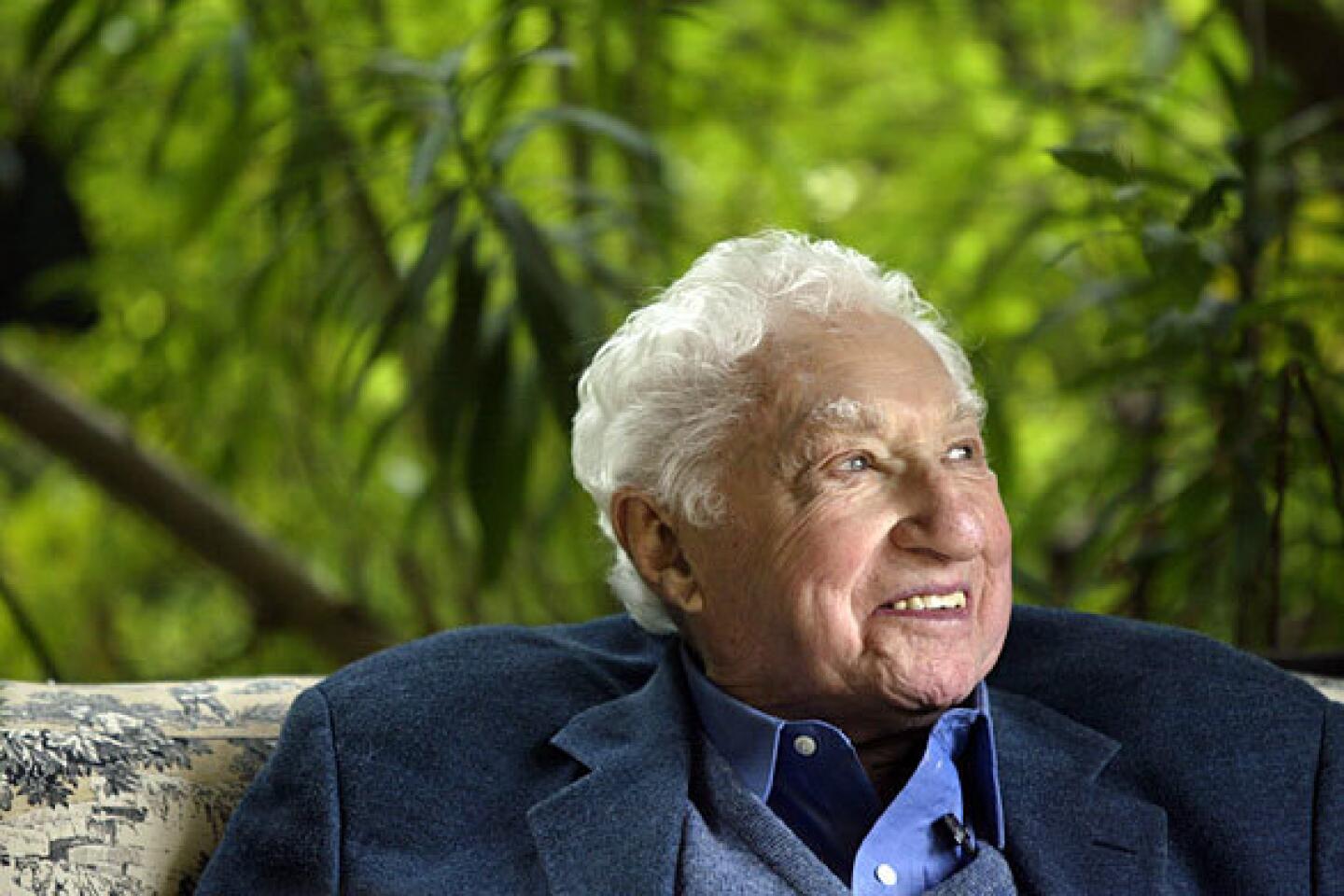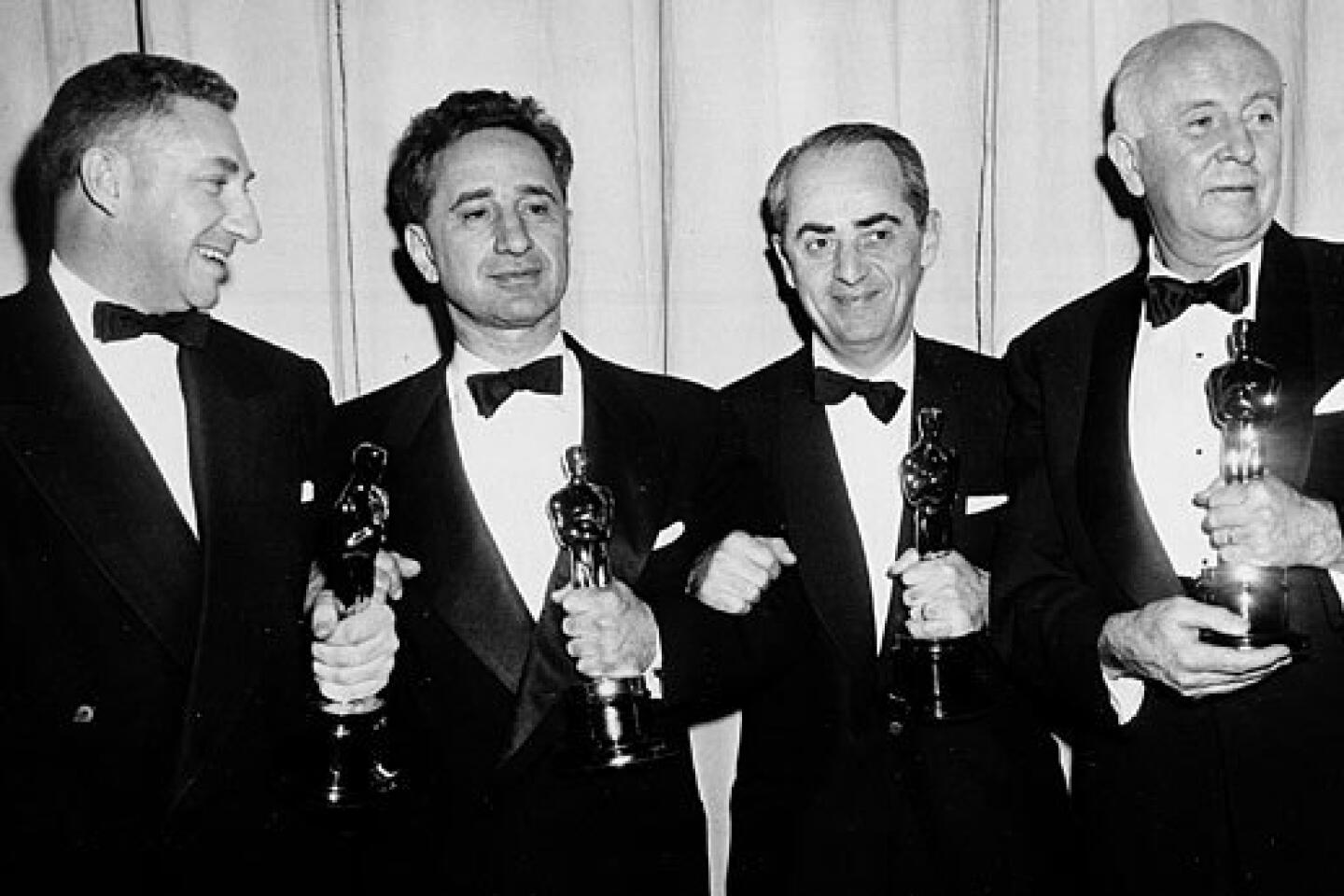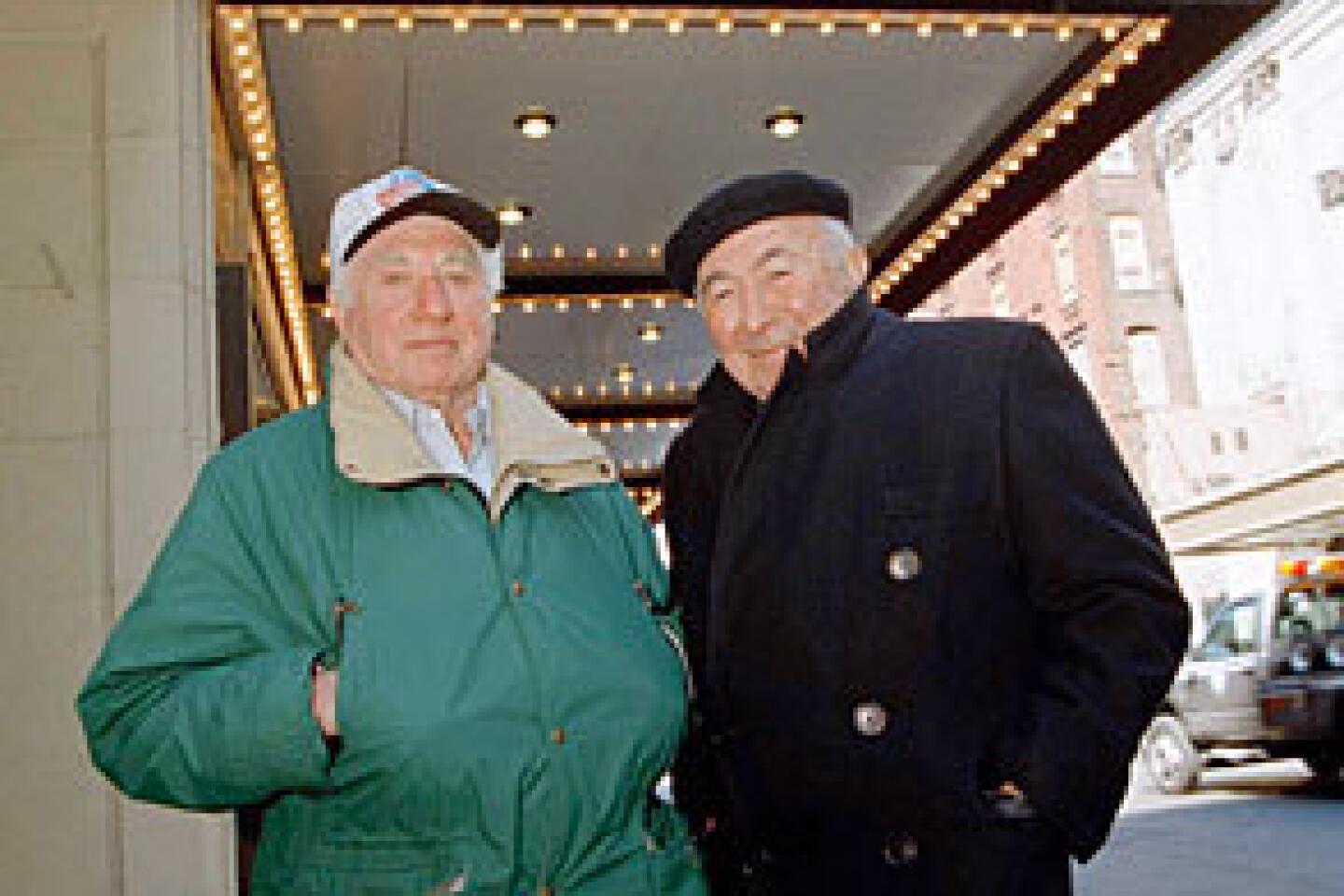Budd Schulberg dies at 95; author of ‘What Makes Sammy Run?’
- Share via
Budd Schulberg, who exposed the dark side of American ambition in his acclaimed Hollywood novel “What Makes Sammy Run?” and won an Academy Award for his screenplay depicting the mob-controlled longshoremen’s union in the film classic “On the Waterfront,” has died. He was 95.
Schulberg, a onetime Communist Party member who was ostracized in Hollywood after naming names before the House Un-American Activities Committee in the early 1950s, died of natural causes Wednesday at his home in Westhampton Beach, N.Y., his wife, Betsy, told the Associated Press.
In a writing career that spanned more than six decades and reflected a strong social conscience, Schulberg wrote novels, short stories, screenplays, plays, teleplays and nonfiction books.
Among his other best-known works are:
* The 1947 novel “The Harder They Fall,” a prize-fighting expose that became a 1956 movie, co-written by Schulberg, with Humphrey Bogart in his final role.
* “The Disenchanted,” a best-selling 1950 novel loosely based on Schulberg’s experience collaborating on a film script with F. Scott Fitzgerald.
* The screenplay for “A Face in the Crowd,” director Elia Kazan’s 1957 movie about a singing Arkansas drifter (Andy Griffith in his first movie role) who turns into a power-hungry tyrant after becoming an overnight national TV sensation.
Schulberg’s resume included being a syndicated newspaper columnist, the first boxing editor at Sports Illustrated and a columnist for Fight Game and other boxing magazines.
He was a lifelong boxing aficionado, and his nonfiction books include “Loser and Still Champion: Muhammad Ali” (1972), “Sparring With Hemingway: And Other Legends of the Fight Game” (1995), a collection of his essays; and “Ringside: A Treasury of Boxing Reportage” (2006).
Greatest success
But Schulberg’s greatest success came with “On the Waterfront.” His screenwriting Oscar was one of eight Academy Awards the 1954 film won -- including nods for picture, director (Kazan), supporting actress (Eva Marie Saint) and actor (Marlon Brando).
Schulberg once said, however, that his proudest achievement was as founder and director of the Watts Writers Workshop. Launched in 1965 after the Los Angeles riots of that year, the workshop lasted until 1971 and spawned workshops in other cities.
“I didn’t want to just hang back and complain about things,” Schulberg later told People magazine. “I thought that we should all do something. I found great poets, great hearts in the ashes of Watts.”
The son of B.P. Schulberg, the powerful production chief of Paramount Pictures in the 1920s and early ‘30s, Budd Schulberg burst onto the literary scene in 1941 at 27 with his first novel, “What Makes Sammy Run?”
A vivid portrait of a brash and amoral young hustler from New York’s Lower East Side who connives his way from newspaper copy boy to Hollywood producer, the novel is considered one of the best about Hollywood, and the name of Schulberg’s back-stabbing anti-hero, Sammy Glick, has become synonymous with ruthless ambition.
‘That horrible book’
Viewed as a savage indictment of the movie business, the novel drew the immediate ire of the Hollywood establishment. As Schulberg once put it: “Overnight, I found myself famous -- and hated.”
Movie columnist Hedda Hopper, encountering Schulberg in a Hollywood restaurant, huffed, “How dare you?”
A furious Samuel Goldwyn, for whom Schulberg was then working as a screenwriter, fired him because of “that horrible book.”
MGM studio chief Louis B. Mayer not only denounced the book at a meeting of the Motion Picture Producers Assn. but also suggested that Schulberg be deported. To which B.P. Schulberg laughed and said, “Louie, he’s the only novelist who ever came from Hollywood. Where the hell are you going to deport him, Catalina Island?”
John Wayne so despised Schulberg’s negative depiction of the film industry in the book -- and, no doubt, Schulberg’s left-wing politics -- that he reportedly attacked the author verbally whenever they met.
Wayne’s wrath finally turned physical when he and Schulberg ran into each other in Puerto Vallarta, Mexico, and the actor challenged the writer to a fistfight at midnight. The 6-foot-4 Wayne managed to get the much shorter Schulberg into a headlock before Schulberg’s then-wife, actress Geraldine Brooks, separated them.
The encounter with Wayne was but one of many memorable incidents in Schulberg’s life -- one that included coming to near-blows with Ernest Hemingway in Key West when Hemingway challenged Schulberg’s knowledge of boxing; playfully sparring with Muhammad Ali in what was then Zaire; and accompanying Sen. Robert F. Kennedy into the kitchen of the Ambassador Hotel in Los Angeles the night Kennedy was assassinated.
Schulberg was born in New York City on March 27, 1914. His film scenario writer-turned-producer father moved the family to Hollywood in 1922 when Schulberg, the eldest of three children, was 8. Schulberg’s mother, Adeline, became a leader of Hollywood society and later a literary agent.
First partnered with Mayer in the now-forgotten Mayer-Schulberg Studio near downtown Los Angeles, B.P. Schulberg became vice president in charge of production at Paramount in 1925.
The family lived in a mansion in the exclusive Windsor Square neighborhood. Schulberg was a timid child who stuttered, raised homing pigeons and wrote from an early age.
But he was a true child of Hollywood’s elite whose playground included the studio stages and back lots of Paramount and MGM.
At Paramount, Schulberg and his best friend, Maurice Rapf, son of MGM executive Harry Rapf, played Foreign Legion on the abandoned fort from “Beau Geste.” At MGM, they watched the filming of the chariot race for the original “Ben Hur” and, hidden from view, threw over-ripe figs at a parade of MGM stars, scoring a direct hit on Greta Garbo.
As Schulberg grew up, it wasn’t out of the ordinary for Gary Cooper to take time out on the set to chat with him or for Cary Grant to drive up in his Model A roadster to present him with a new dog.
And Schulberg had to be the only kid in America who sold magazines on a street corner after being dropped off in a chauffeur-driven, custom-made town car modeled after an 18th century coach.
Schulberg captured those early days in “Moving Pictures: Memories of a Hollywood Prince,” his 1981 memoir of his life with his film-pioneer father.
Favor seekers
But the writer grew contemptuous of Hollywood, which the public may have viewed as the glamour capital of the world but which “B.P.’s little boy,” as he was referred to, saw as a company town.
“If you were raised in Hollywood, it wasn’t too difficult to get pretty angry at the world around you,” Schulberg told People magazine in 1989. “People would come up to me when I was a little boy -- 11, 12, 13 -- an actress would want some favor from my father; a writer would urge me to say something about him. That was all around me. When they fussed over me, I knew why.”
Schulberg’s golden life tarnished in 1931 when his father, a gambler and philanderer, moved out of the house to live with his latest discovery, actress Sylvia Sidney.
By then, the 17-year-old Schulberg was working in the Paramount publicity department, writing fictitious biographies of the studio’s stars.
After earning a bachelor’s degree from Dartmouth College in Hanover, N.H., in 1936, Schulberg returned to Hollywood, where he spent the next three years as an apprentice screenwriter for producers David O. Selznick, Walter Wanger and Sam Goldwyn. Among his assignments: writing additional dialogue for “A Star Is Born” and collaborating with Fitzgerald on the “Winter Carnival” script.
Schulberg had already published short stories in magazines when he moved to New Hampshire in 1939 to write “What Makes Sammy Run?”
In his later years, Schulberg lamented that his work had become “a handbook for yuppies,” who had seemingly come to embrace Sammy’s credo of success at all cost. “Going through life with a conscience is like driving your car with your brakes on,” Sammy says at one point in the novel.
Serving in the Navy during World War II, Schulberg was a member of director John Ford’s documentary unit. After Germany’s surrender, Schulberg spent six months examining secret German films for visual evidence of war crimes.
The writer had been a member of the Communist Party from 1936 to 1939. He later said he became disillusioned with the party at the time of the Hitler-Stalin pact and quit after party members in Hollywood tried to dictate how he should write “What Makes Sammy Run?”.
During his appearance before the House Un-American Activities Committee in 1951, Schulberg named 17 people he said he had known in the Communist Party.
“It’s not a pleasant thing,” he said of naming names in a 2000 interview with the Hollywood Reporter. “My own feeling was that while I didn’t like the committee being so right-wing, I didn’t think it was healthy having a secret organization trying to control the Writers Guild. I felt it was wrong and undermining democracy.”
Many felt that the “On the Waterfront” plot, in which a longshoreman (Brando) courageously testifies at a waterfront crime commission public hearing against the vicious mobster who controls the dockworkers’ union was an allegory for Kazan and Schulberg’s friendly testimony during the committee’s investigation into communist influence in Hollywood.
Kazan did not reject the parallel, writing in his autobiography, “I put my story and my feelings on the screen, to justify my informing.” But Schulberg strongly denied that “On the Waterfront” was his apologia for testifying.
“It’s total, total nonsense,” he told the Chicago Tribune in 1994, saying he had welcomed the opportunity to renounce the Communist Party before the committee.
In writing “On the Waterfront,” he said, “I was interested in social conditions on the waterfront and drawing a truthful story, not in justifying my position. Can you imagine Kazan asking me to write something that would justify our friendly testimony? It’s a shame that an inaccuracy like that has become a ‘fact’ when it simply couldn’t be more wrong.”
Denial supported
A Fordham University professor supported Schulberg’s denial, telling the New York Times in 2003 that he had found an early “Waterfront” script among Schulberg’s papers that had a similar theme but was written before his congressional testimony.
Of those who see links between “On the Waterfront” and his testimony, Schulberg told the Chicago Tribune: “Let them say what they want, but they’re missing the point of the film, which was not about informing but about men standing up to the mob for their rights on the docks. I’m proud of it for a lot of reasons: We prevailed over the enormous resistance of the studios and got it made, and we also proved we could hold an audience and say something we believed in.”
Schulberg is survived by Betsy, his fourth wife. Information on other survivors was not immediately available.
More to Read
Start your day right
Sign up for Essential California for the L.A. Times biggest news, features and recommendations in your inbox six days a week.
You may occasionally receive promotional content from the Los Angeles Times.









